
16 minute read
Winter sports mural
Joey kauffman ’23
Apart from early childhood and four years of college, Teacher Louie Brown ’15 has almost always been around Haverford. Twenty-five years old, Teacher Louie has spent sixteen of those years at Haverford, as a student for fourteen years, and recently, as a teacher of English I and English III: American Literature for the past two years, and last year, Ancient World History.
Advertisement
“I wanted to be a teacher, and I always had this idea that I would love to come back and teach at Haverford,” Teacher Louie said. “It’s sort of my dream job.”
After majoring in English at Vassar College while also taking education classes, Teacher Louie wanted to engage with a community that held signi cance.
“I really like the idea of recommitting to a place,” Teacher Louie said. “I like these kinds of long-term things that help my life feel like it has continuity and consistency.”
In college, Teacher Louie expanded their ideas on education and began to understand the desire to teach at Haverford.
“But throughout College, especially with taking education classes and learning about pedagogy and progressive education and how deep of a craft and a science teaching is, I thought it would be just cool to come back and work here,” Teacher Louie said.
Still, Teacher Louie did not expect to devote years to Haverford so early in a teaching career.
“I really had always thought that I would go out, and I would start my career in other places, and I would come back to Haverford as a very seasoned teacher. And so that was extremely di erent because I came into Haverford as a complete novice, and I had to do so much learning, and I’m still doing so much learning,” Teacher Louie said.
After returning, Teacher Louie has recognized similarities and di erences between past and present versions of the school.
“ ere was a lot that I was surprised by when I came back, just in terms of how much students knew and were tuned in to issues of social justice and social rights and the language and the vocabulary of those kinds of elds,” Teacher Louie said. “Because when I was here, besides the people in the Diversity Alliance, no one knew anything about that.”
Beyond the increased awareness of social justice, Teacher Louie saw a through line in the quality of education.
“ e student body at Haverford is particularly good at following rules and paying attention, I think, or at least they were responsive enough to me,” Teacher Louie said.
Teacher Louie provided a memorable presence on campus, managing to challenge outdated norms and push students to think critically, while remaining a gentle, kind gure.
“One of the areas of personal importance to me in education is in gender and sexuality,” Teacher Louie said. “So it was kind of an appealing idea for me to be in the center of masculinity and see what it felt like to try and change things or observe things and understand things better and then move the dial a little bit.”
One of Teacher Louie’s most striking ideas about gender is about the existence of Haverford as an all-boys institution.
“I think there will be a big audience for [single-sex education], but I also think it is not very modern—I think it’s a model of a pre-twenty- rst century, digital-age society—and things are changing,” Teacher Louie said.
Despite these ideas on education—or more likely because of them—Teacher Louie focused on being the best teacher they could be inside of the classroom.
“I have these big ideas about pedagogy and education and all these issues or things that I perceive that could be di erent in our education systems. But at the end of the day, it’s like I’m really one person, and I want to make sure that my space and the thing that I have the most control over is the model of what I want the bigger things to look like.”
For the moment, Teacher Louie plans on staying in the Philadelphia area, taking on some part-time jobs, and working on “life skills” outside of the teaching profession. After that, Teacher Louie will probably go to graduate school, possibly in Environmental Sciences or Environmental Education.
Still, if there is one thing that Teacher Louie has learned, it is that life surprises.
“Even though I’m here in this same geographical space, it’s like I’m not even close to the person that I thought I would be when I was in high school,” Teacher Louie said. “And I’m really happy about that, and I’m happy that I’ve lived a life that has surprised me, and that has led me to understand new things about myself and what I care about and what I like.”
Teacher Louie Brown ’15
PIERCE LAVERAN ’23
Sixth Form students create winter sports mural for graduation project
Ethan lee ’24
As students roamed the area around the art studios during the last three weeks of school, they may have heard music playing from the Durham Community Room. The sound comes from Sixth Formers Peter Kaplan, Fisher Bond, Judah Cannon, and Ned Cutler, who have been hard at work creating a mural that will reside on the wall next to the outside basketball court.
The mural celebrates the school’s winter sports teams. Bond echoed this sentiment.
“Out on the lacrosse wall there are already two murals there,” Bond said. “There is a blank panel, and we all love art, so it felt right and felt like a good way to make our impact on the school that will be there for 10-15 years.”
The project began prior to graduation projects. Kaplan had been planning this mural ever since his sophomore year, right before COVID-19 broke out.
“I was playing lacrosse on the wall one day, and I noticed that winter sports were not recognized,” Kaplan said. “I went to Mr. Fox, and he helped me get approval from [then Head of School] Dr. Nagl, Mr. Casertano, and Mr. Murphy.”
Kaplan also had to consult the outdoor design committee of the school. Afterwards, the group began an iterative design process, working through multiple designs of the mural.
“There were a lot of designs when we first started, but we were able to narrow it down to three, then one,” Kaplan said.
“Even now,” Cannon said, “we are still tweaking it as we are finishing it.”
The first thing they did was put together the canvas, made out of a thin, paintable fabric.
“We measured the wall and made sure the fabric was cut to the appropriate length,” Kaplan said. “It was surprisingly difficult to staple the pieces together on the wall. We had to spend a lot of time making it straight and flat. The painting has gone relatively fast.”
The group projected an image on the wall to aid them in the painting process.
The athletes on the mural are based on students in the graduating Class of 2022.
“The basketball player is Isaiah Boyd, the squash player is Mitav Nayak, the hockey player is Peter Kaplan, and the wrestler is Max Rosenberger,” Cannon said.
“The last figure is a swimmer/diver,” Bond said. “You can’t really see their face in the painting, so it’s kind of a generic guy.”
As they wrap up the painting, the group will take it down from the Community Room and put it up on the basketball court wall. They will finish it with a clear coat to protect it from the weather, allowing future generations to see all three sports seasons represented in a public space.
PETER KAPLAN ’22

academics
Year-end projects complement traditional assessments
Ian Rosenzweig ’25
This school year, students increasingly experienced school activities and traditions in “normal” fashions. Intellectual Curiosity (IC) Day returned from a COVID-induced hiatus, the entire upper school attended in-person assemblies in Centennial Hall, and the ird and Fourth Forms returned to the dining hall for lunch. Still, many students do not experience one trademark upper school experience— nal exams.
Instead of formal exams, many teachers have devised interesting projects to culminate the year, assess knowledge, and offer some fun before summer vacation. Many students are gearing up to demonstrate their learning in creative, untraditional ways.
Students in Mr. Ator’s and Mr. Fus’s geometry classes are working in hallways near windows with sightlines of the upper school building. For their project, students measure the volume of Wilson Hall. Although the classes do have a test to end the year, the project is a fun way for students to use all of their new skills.
This project is no easy task because the building’s shape is unique. Mr. Fus and Mr. Ator hope to engage their students in an authentic project that assesses not just their mastery of content but also employs their teamwork, application, and problem-solving skills.
“They have to use all of the skills that they’ve learned… in a unique context,” Mr. Fus said. He stresses students’ innovative thinking and said, “It’s really cool to see [the students] thinking [and coming up with] cool ideas.”
The project also helps the teachers assess thinking processes.
“In the end I am much less interested in each group finding an accurate answer than I am in them demonstrating an ability to make a plan using the skills they learned and executing it to the best of their ability,” Mr. Ator said.
As vacation looms large in students’ minds, Mr. Fus and Mr. Ator hope that this project keeps their students interested.
“We wanted to end the quarter with a project that still tested the students’ understanding but was a little more interesting than a ‘normal’ test,” Mr. Ator said.
Mr. Fus said, “The end of May into June is a hard time in the year, and this year I noticed my students being fatigued… Part of that is not being used to this pace and rigor. If I tried to teach the way I usually do, they would not be as enthusiastic and interested as they are with the project.”
Across the building and up one floor, Dr. Fenton’s Latin II* class took a break from their typical translations, grammar constructs, and Roman graffiti to dive into Roman religion, ritual sacrifice, and augury. One of the class’s final projects involves researching, organizing, and conducting an authentic Roman sacrifice ceremony (using a stuffed animal). Students must strive for authenticity in composing a prayer and reenacting a sacrifice. Then, they examine the fake entrails of the stuffed animal using a 3-D printed model of a liver to infer which deity is sending them a signal. They compile their results in a written report.
“I always like to say it’s like a lab report…we’re doing [Roman] science here,” Dr. Fenton said.
Although language classes, which build cumulatively, often hold final exams to assess a student’s retention, Dr. Fenton prefers to give projects.
He said, “Projects are a lot more interesting and engaging. I particularly like projects that require students to integrate the Latin language, history, literature, and mythology, into a larger whole.” Dr. Fenton likes the sacrifice project in particular because it “requires students to compose something in Latin using some of the grammatical constructions that they’ve learned, but it also requires them to show what they learned about Roman culture, religious practice, and history.”
Dr. Fenton also believes that projects are more engaging and educational.
“It’s fun to do something that’s out of your comfort zone. It is absolutely a ridiculous thing to do to be wearing togas and lighting a fire and singing songs to a Roman deity, but that’s what education is about— pushing yourself to do something that’s new and weird and outside of your comfort zone,” he said. Sixth Formers in the honors history elective, The History of Science, Sex, and Culture, completed a final project that reflected their understanding of their course while also preparing them for the next phase of their academic careers. In Dr. Gurtler’s quarter-long elective, students study cultural constructs and debates about gender and sexuality. For their final project, the students in this class integrated their learnings into a 21st-century Parenting Manual.
Dr. Gurtler believes that this project encourages students not only to demonstrate their understanding but also to “think about how to talk about these issues, like gender and sexuality, with people of different ages,” a task for which they must have a deep and thoughtful analysis of course content.
She also thinks that the component of the project for which students reflect on their own upbringings is “important for seniors in particular.”
Dr. Gurtler believes that the class, as an elective course, lends itself to a project-based learning model. She also notes that “teachers know that many students lose steam by the end of the year.” In particular, keeping a class of fourth-quarter Sixth Formers interested and engaged can be a challenge. But Dr. Gurtler found that the project is a fun way to end the year and also an “easy-going way to talk about really tough issues.”

COURTESY OF DR. ANDREW FENTON
Some of Dr. Fenton’s former Latin students preparing for an “animal sacrifice” in 2018
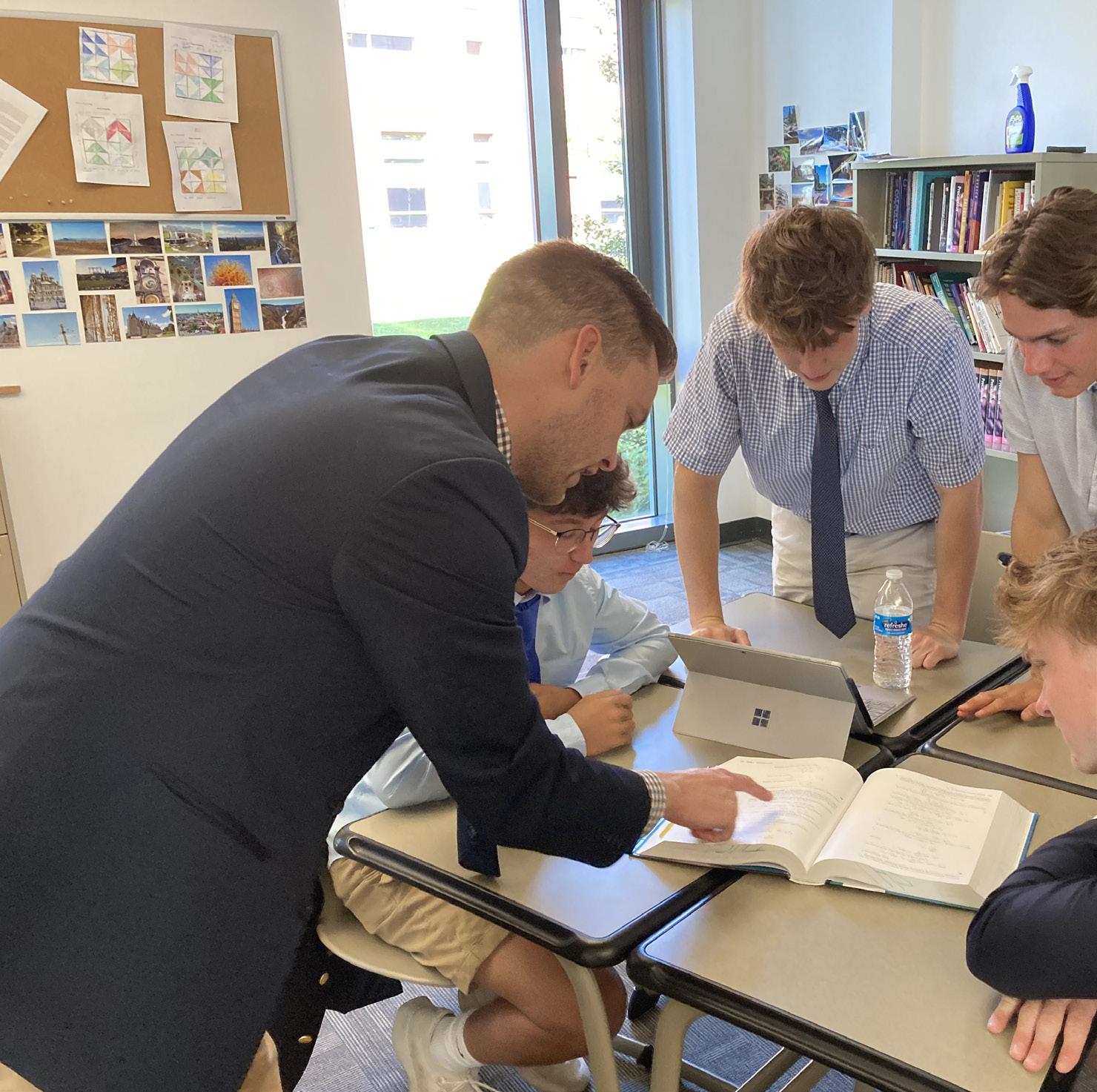
DR. ANDREW FENTON
campus opinions
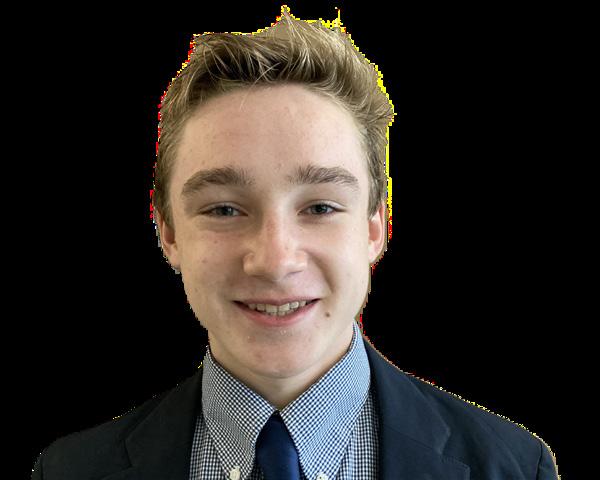
The value of opinions
Connor simpkins ’25
The Campus Opinions section of The Index has touched on many topics this year. Students have passionately articulated their positions on different topics, from Fourth Former Arsh Aggarwal encouraging a more unified upper school community to Sixth Former Colin Stewart highlighting the challenges of the late lunch block. Fifth Former Joey Kauffman advocated for clearer school policies around technology and privacy, while Sixth Former Ryan Rodack raised awareness about the challenges of student parking. Every month students had much to say about life at our school.
There is no doubt that diversity of opinions is important. We all want to be at a school where we have the agency to write about issues in our community, issues we feel strongly about. And many student voices provide context and perspective; they let us view our community through a wider lens.
Opinion articles can be challenging to write. One must strike a balance between thoughtful insight and privileged complaint. At a school as well-resourced as Haverford, it can be hard to justify every complaint. While we should always strive to improve our community, it is equally important to acknowledge what is going well within the walls of the school. And so, as we close out the year, let’s end with gratitude.
In quick and informal conversations with classmates, I asked for opinions about what went well this year and what my classmates were grateful for. I heard a story about a teacher who helped with a late submission for an extra-credit project, an art teacher who came in early so that a project could be finished so an after-school sports practice didn’t get missed, and dining hall staff that let a student buy breakfast even though the dining hall was technically closed.
A librarian helped a student find one vital, yet elusive resource; the office staff held onto a gym bag forgotten in the rounders for a week; a coach gave a key word of encouragement at just the right moment; an English teacher helped with a dreaded public speaking assignment; a security guard, with a nod and a wink, looked the other way so a small group of guys could sneak into a soldout game.
It took little effort to learn about all the small ways things went right this year, all the ways students were grateful for the Haverford school community.
In his September 2021 opinion piece “We need a more unified upper school this year,” Fourth Former Arsh Aggarwal wrote, “We come to school because of the experiences we have with each other—not only as a class but as an entire upper school.”
As we end the year, these words ring especially true; it is the experiences we had with one another that, in fact, made it a great year.
We all want to be at a school where we have the agency to write about issues in our commnuity, issues we feel strongly about. ...it is the experiences we had with one another that, in fact, made it a great year.
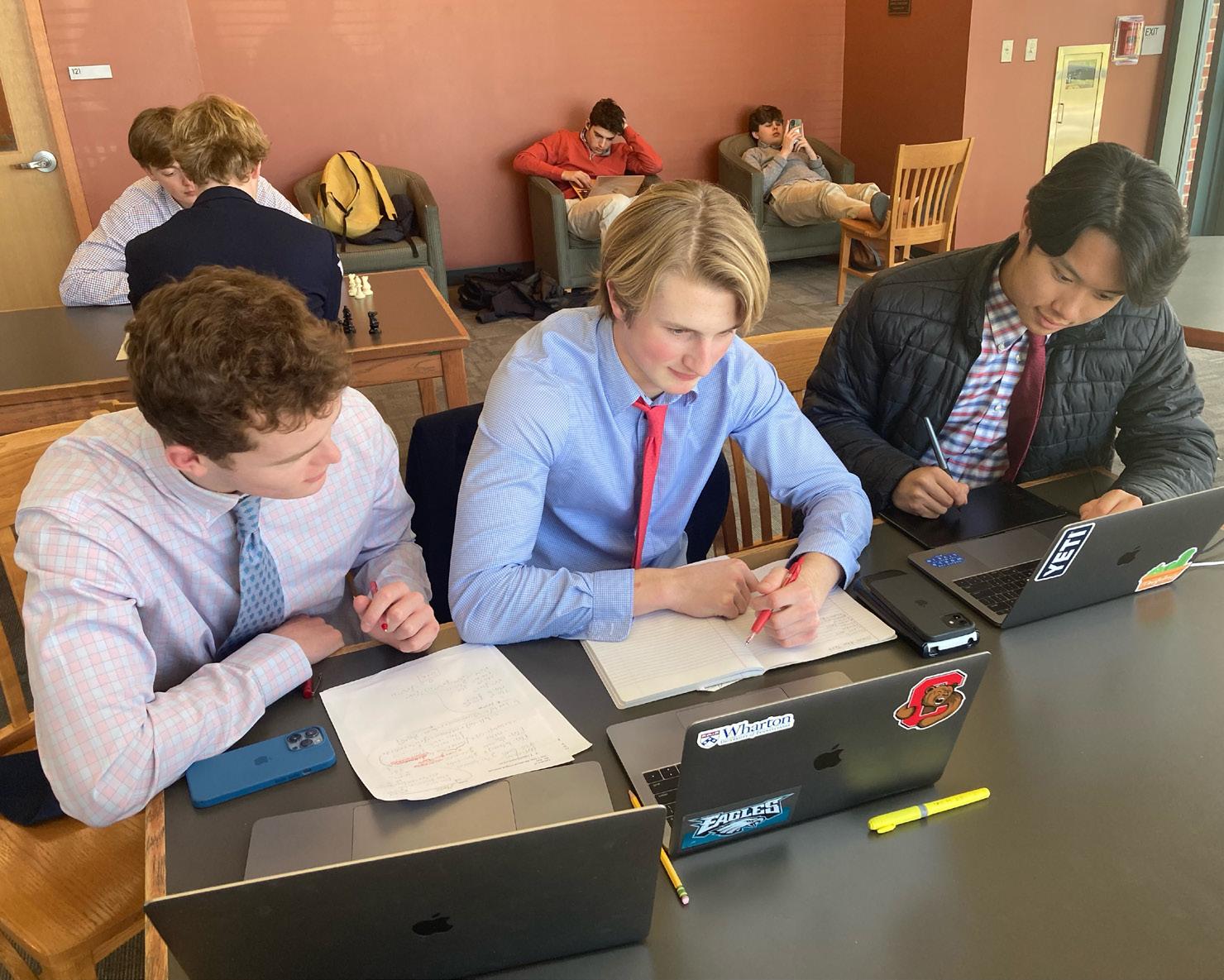
JOEY KAUFFMAN ’23
Students study together in the library
Mr. Brian McBride, The Index thanks you for your love of our school
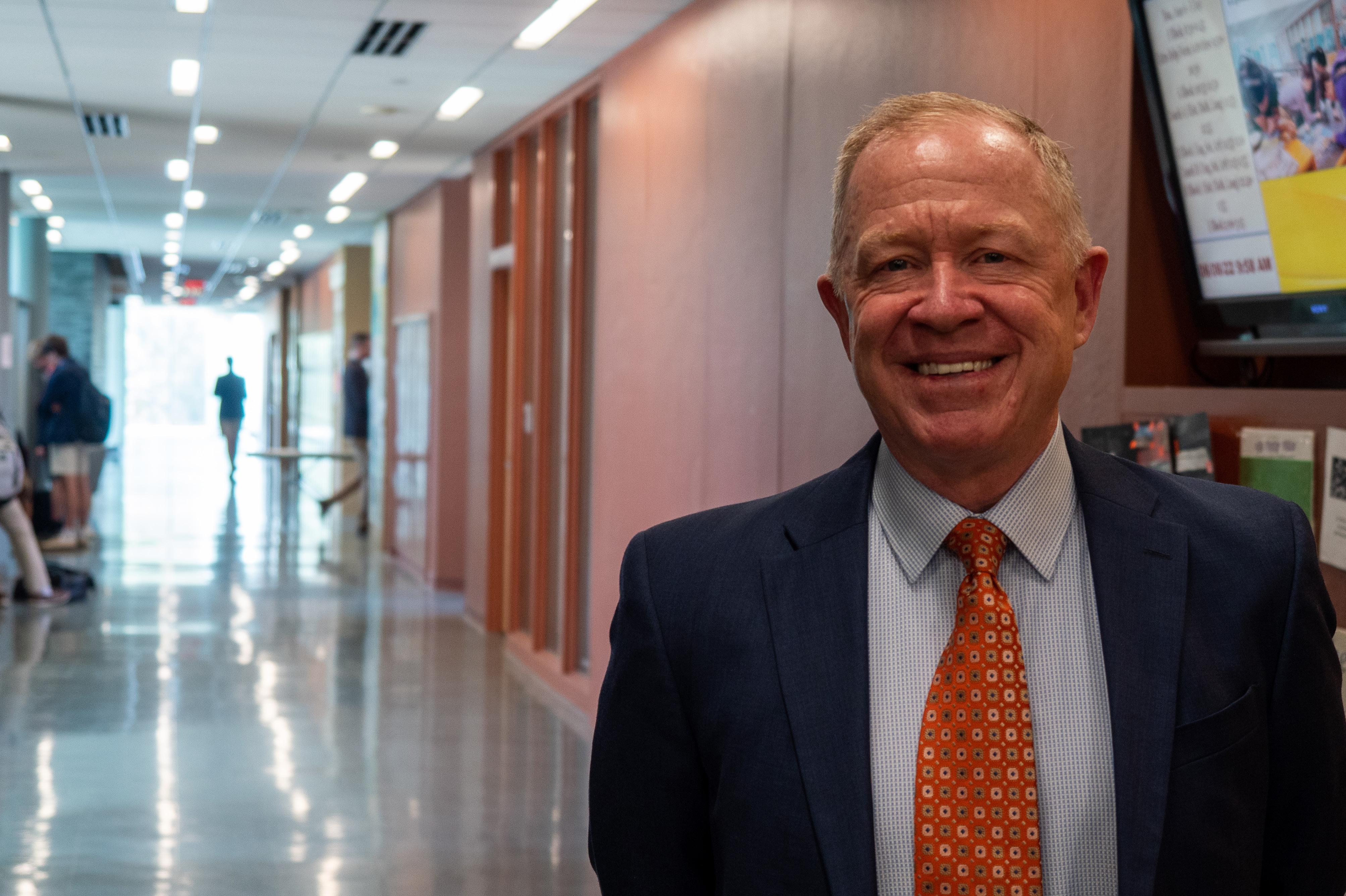
The Index wishes Mr. Mark McConnon the best at his new school
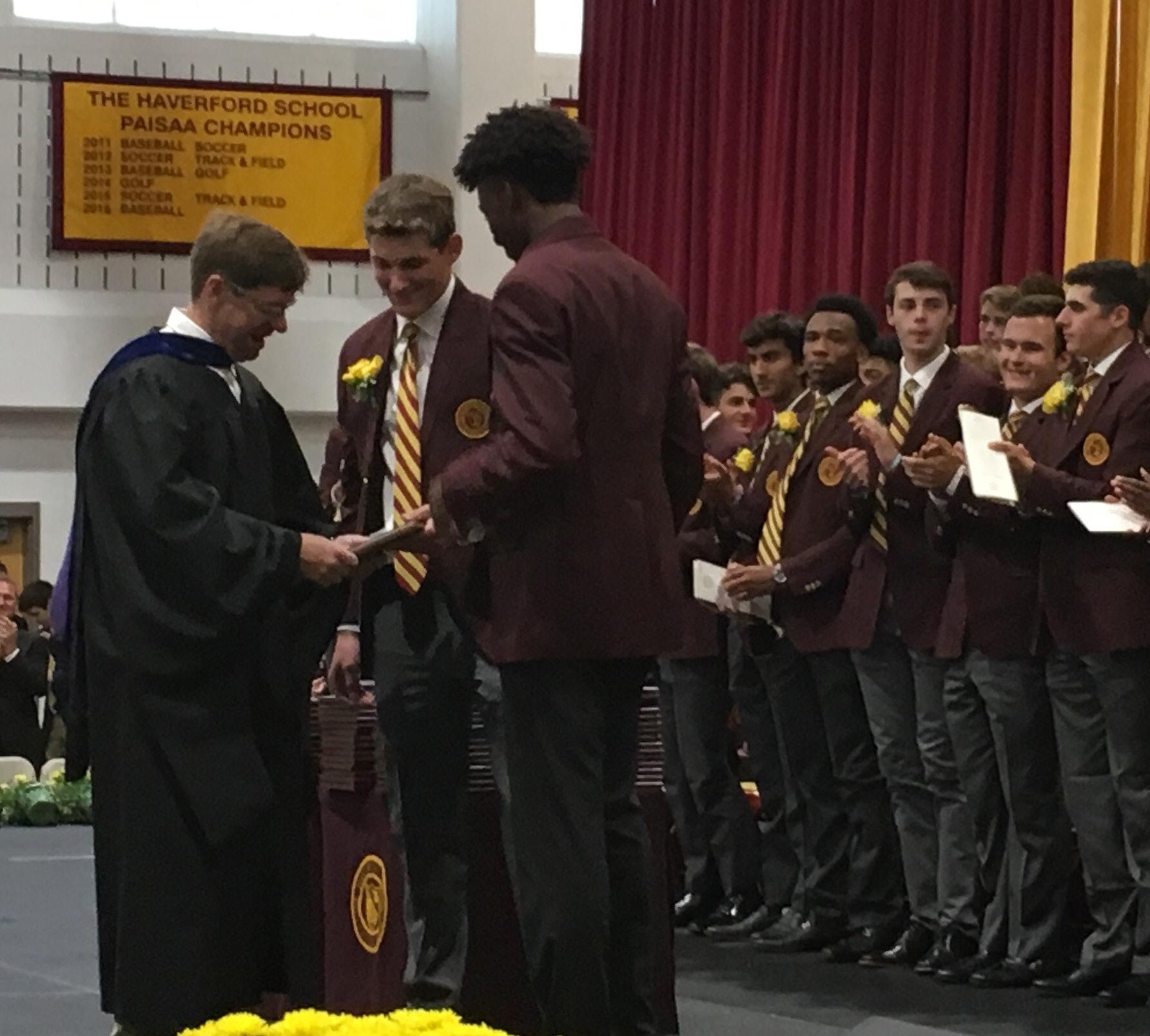
Mr. McConnon recieves the Class of ’96 Rafael Laserna Outstanding Teacher Award, June 7, 2019
INDEX STAFF
The Cold Email

Will Rubin ’22
The cold email. It’s scary, intimidating, yet exciting. In January, I sat in the library, obsessed with each word I was about to send. I was determined to work at a trading firm for my graduation project. Susquehanna International Group (SIG) was the cream of the crop for that, I had recently learned from Mr. Long. The email was my plea for a seat on their famous poker-inspired trading floor.
Surprisingly, SIG received my signal. In between Chris and John, two away from the famous quantitative analysts, and six away from the company’s CEO, John Zhang, Zach Hoyt, and I were working in the eye of the trading storm. And if it couldn’t get any cooler: we were working on crypto.
The crypto world, known for its memelike stories and Elon Musk tweets, contains a j-curve of knowledge: the more you know, the less you know. John, Zach, and I witnessed this firsthand. On our first day, we likely had an average of 1,000 “lightbulbs” light up; “I think I get it,” Zach said.
We rolled to his desk, and he showed us a graphic. We looked at each other with wide eyes and celebrated our new understanding. The cycle continued with each of us taking turns demonstrating our competence. Curiosity led us deeper into the rabbit hole, eventually popping out in the wonderland of crypto. The topic of our desk meetings helped us to realize we knew nothing—NFT video games, decentralized exchanges, Uncle Blocks, and much more.
SIG also brought new ideas for a Haverford Blockchain Club. Every day, my conversations with Zach and John were fun and thought-provoking. They revolved around anything crypto-related and usually resulted in heated discussions over what we would do in different protocols.
These great conversations eventually led us to think up a place at Haverford where the same could happen every week.
Through this whole process, I found what it meant to be a Haverford man. While at times I might have felt lost and stressed, I had two of my brothers sitting next to me. They were just as confused sometimes, if not more.
Those moments of strife, though, were the times when we came closest together— literally. Huddled around a monitor, squinting to see correctly, we experienced what Mitav and Mr. Casertano have been preaching all year: support.
So make sure to send your cold emails. Check every word, write a good hook, and take the time to stress over the send button, because you never know where it will lead you.
I expected to find a new love for finance, and instead, I found family.





